✕

Column: industry Tag: garofalo,barilla,pasta Published: 2024-11-20 15:41 Source: www.mashed.com Author: HELENA NICHOLSUPDATED: NOV. 19
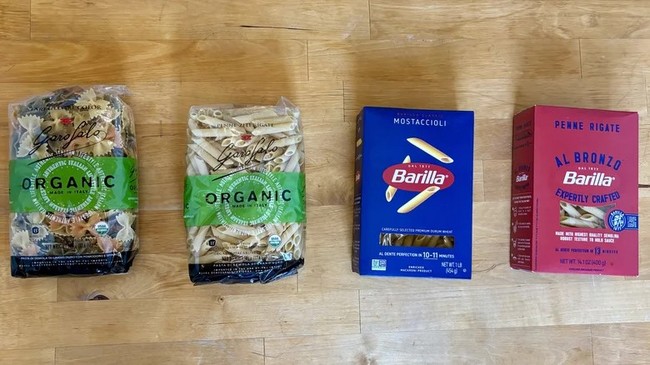
Helena Nichols/Mashed
Barilla is a big-name brand of dried pasta in America. However, as tastes have changed and availability has expanded, other brands are growing in prominence. I'm pitting one of those — Garofalo — against Barilla to find out which is the better pasta.
One reason why I am comparing these two brands is because of varying product packaging. While Barilla pasta varieties are widely available in individual packages at several major supermarket chains, Garofalo pasta is frequently sold in bulk-package options at outlets like Costco. So, if you are buying a large amount of Garofalo at one time, you are committing to eating a whole lot of that brand's pasta. You do not want to be disappointed with what you get.
To decide which brand is the best, I will experiment with different pasta shapes and types of pasta to get an overview of what each producer offers. I carried out a taste test that factored in each pasta's texture, but also considered price, nutritional content, and ingredient quality to find out which brand offers the best products. As someone who eats a lot of pasta in her daily life and occasionally uses a homemade pasta recipe to prepare it from scratch, I am excited to put these two pasta brands to the test.
What is Garofalo pasta?
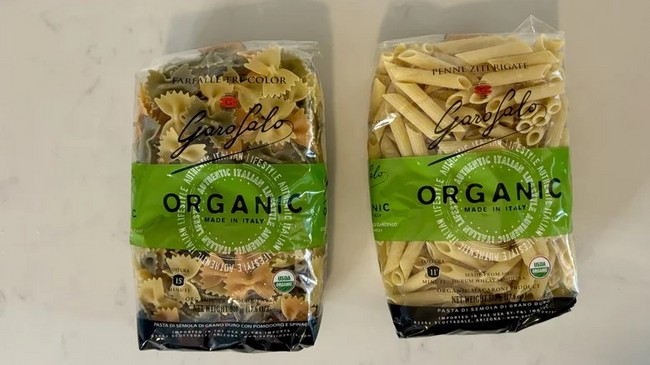
Helena Nichols/Mashed
Garofalo may be an emerging name in American pasta culture, but the brand has a long history in Italy. The company was founded in 1789 in Italy's community of Gragnano, not far from the Bay of Naples. While pasta probably didn't originate in Italy, Gragnano has a long history of pasta production, and it's considered as the origin of high-quality dried pasta. Over the centuries, Garofalo established a reputation as a producer of impeccable pasta.
If Garofalo has such a long and respected history, why does it not have the same distribution and name recognition as competitors like Barilla? Well, for a long time, Garofalo pasta was offered as a private-label product, meaning the company would sell pasta to other brands that would market Garofalo's goods as their own. This changed in 2001, when Garofalo launched its own consumer brand. Things for the company expanded again in 2014, when Ebro Foods became a major stakeholder in Garofalo and helped it grow internationally.
While many companies aim to provide quality products on a mass-produced scale, Garofalo appears to still strive to offer pastas with a handmade feel. The company makes a durum wheat semolina pasta, an organic whole durum wheat semolina pasta, and a gluten free pasta.
What is Barilla pasta?
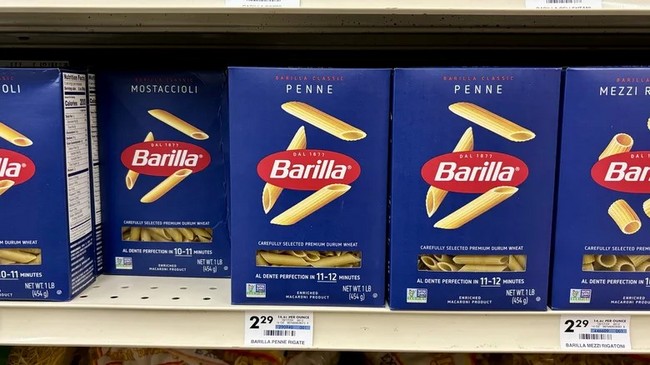
Helena Nichols/Mashed
Barilla is one of the most well-known pasta brands, not just in the United States, but around the world. Barilla started out as a little shop opened by Pietro Barilla in Parma, Italy. That was in 1877. The company's first factory was built in 1910, and in 1969 Barilla opened an immense production plant capable of producing 1,000 tons of pasta per day. No wonder the company was able to spread its pasta globally.
Today, Barilla is still a family-run business overseen by three Barilla brothers: Guido, Luca, and Paolo. The company has expanded far and wide — beyond its multiple factories in Italy, Barilla has production facilities in countries like the United States, Greece, Turkey, and Sweden, just to name a few.
However, the company is still based in Parma, staying true to its historic roots. Nonetheless, over the years Barilla has gone far beyond offering an array of classic pastas. Barilla now produces a selection of sauces, and has expanded its pasta selection with offerings like a high-quality line called Al Bronzo, whole grain pastas, or microwavable ready-made pasta — and Barilla's new gluten-free pasta has just one ingredient: chickpeas.
Where are Garofalo and Barilla pastas made?
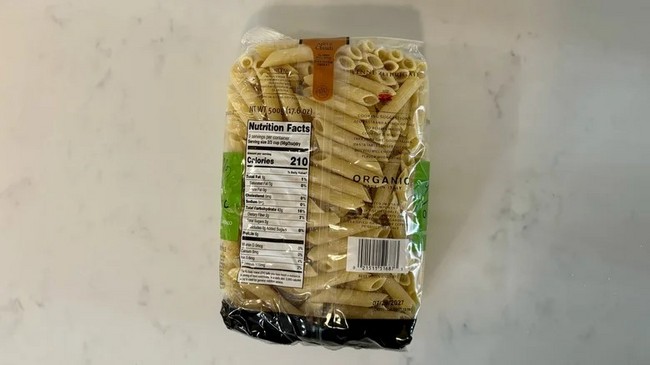
Helena Nichols/Mashed
One of the biggest differences between these two companies is where the factories are located. While both companies have Italian names, only one company produces its pasta exclusively in Italy: Garofalo.
Garofalo boasts its products' PGI certification — standing for protected geographical indication — which ensures that the pasta is made in Italy to demanding specifications. In the same way that Champagne can only be called Champagne if it comes from the Champagne region of France, many Garafalo products bear a "Pasta di Gragnano IGP" seal indicating that the pasta comes from Gragnano, where the company's factory is located.
Barilla has multiple American production facilities. One is in Ames, Iowa, while another plant is in Avon, New York. The company does offer products that come from Italy, but those are clearly labeled with that origin specifically on the packaging. However, Barilla management notes that the company uses the same machinery in its U.S.-based plants as in its Parma facility, with an aim of maintaining the same standards amongst all production centers.
One pasta brand offers more nutrients
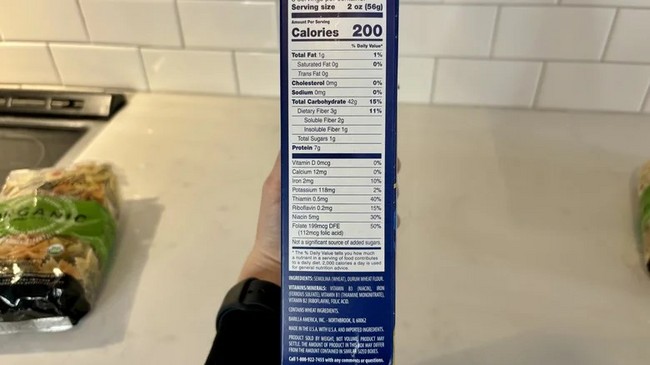
Helena Nichols/Mashed
An interesting difference between Barilla and Garofalo pasta is the nutritional components. One might think that they would be quite similar, considering that the ingredients are essentially the same, but there is one key difference: some Barilla pasta varieties apparently have higher levels of nutrients than options offered by Garofalo.
For example, if we look at the penne pasta offered by the two brands, Barilla's packaging lists B vitamins and folic acid among its ingredients, and each serving features 2 milligrams of iron. Meanwhile, a package of Garofalo penne has no mention of B vitamins or folic acid clearly labeled in its nutrition facts, and offers less than a milligram of iron per serving. This is an important difference, especially when you consider that an estimated one in four Americans need more iron in their diet, and many people have insufficient levels of B vitamins in general.
Vitamins and minerals aren't the only factors to consider, though. Again, using the penne from both Garofalo and Barilla as examples, we see that general nutrition facts are fairly similar. For a 2 ounce serving, Garofalo has slightly higher calorie count of 210 versus Barilla's 200. However, both have the same amount of fat (1 gram), while Garofalo has 43 grams of carbs to Barilla's 42, and Garofalo has 6 grams of protein while Barilla boasts 7 grams. These are negligible differences in the grand scheme of things, but they show that the biggest nutritional differences are due to Barilla's increased levels of minerals and vitamins.
A food of few ingredients
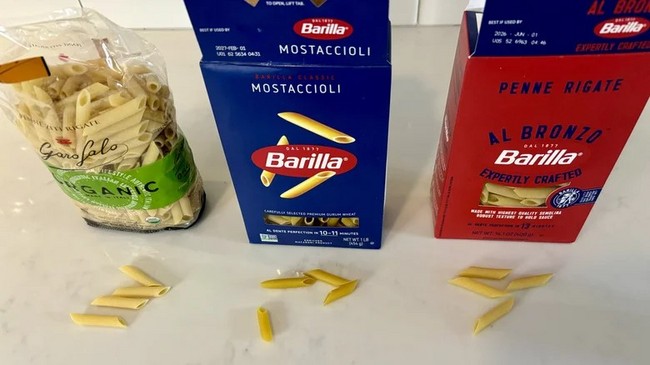
Helena Nichols/Mashed
Pasta, in general, is not made from many ingredients. In fact, if we look at the basic white pasta, both brands only use durum wheat as an ingredient, and that is it. The labels of both Barilla and Garofalo state that the pasta is made with semolina. What is semolina, you may ask? It's simply a course-ground type of flour made with durum wheat. While water is not listed with the ingredients, the semolina is mixed with water, which creates the dough that is used to make pasta.
In addition to Barilla's classic pasta products, the brand also offers its Al Bronzo line that is supposedly made with higher-quality semolina. However, the Al Bronzo ingredients appear similar to Barilla's standard pastas. I also tried Garofalo's tricolor pasta, which, in addition to the semolina, also has spinach and tomato infused into the product to provide its green and red hues.
Both companies also offer selections made without gluten, though neither brand's products were featured on a previous Mashed list of the best gluten-free pastas. Barilla's version primarily consists of corn flour and rice flour, while Garofalo's gluten-free pasta includes both of those ingredients as well as brown rice flour, potato starch, and quinoa.
Pasta shapes available
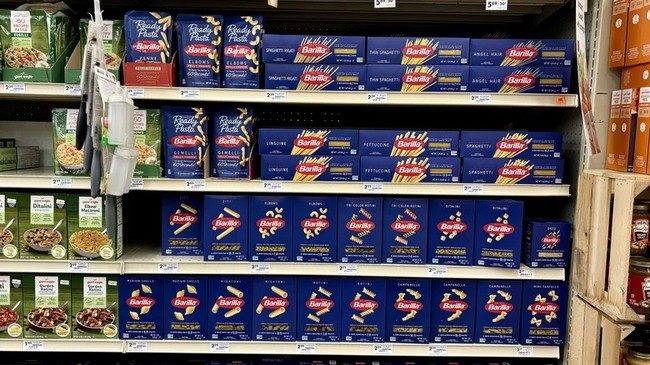
Helena Nichols/Mashed
Logic would tell us that varying shapes of pasta makes no impact on its taste. However, the real reason pasta shapes taste different is because the variety of shapes are specialized to hold sauces of assorted consistencies — slender pasta like spaghetti works better with thinner sauces, while thicker sauces work better with tube-shaped pastas. Both brands offer the basics — fettuccine, penne, farfalle, and the like. There are too many individual styles to name. However there are some key differences in the offerings.
For example, Barilla offers cellentani, which is basically tubular corkscrew-shaped macaroni, but we couldn't find this option produced by Garofalo. However, Garofalo produces spinach-infused tagliatelle primavera, which is sold in packages of small nests that look like something you'd buy in a specialty delicatessen, and no comparable product appeared online when searching for an equivalent option from Barilla. In this particular respect, the pasta-style competition is really a toss-up between the two brands, depending on what your dish calls for.
Of course, I can't forget my gluten-free friends. Garofalo offers gluten-free linguine and spaghetti, as well as a penne and a casarecce. But Barilla offers gluten-free fettuccine, spaghetti, penne, elbow macaroni, rotini, and oven-ready lasagna sheets, besting Garofalo's selection by two products.
Where can you buy Garofalo and Barilla pasta products?

Helena Nichols/Mashed
Accessibility is a big determining factor in deciding which pasta to buy. If you can't locate the pasta, you certainly can't eat it. Barilla undoubtedly has the better distribution among the two brands. I have already discussed how they are one of the top-selling brands globally, with factories across the world. With that kind of distribution, it is easy to find Barilla at any number of shops. My local grocery store chain has a selection of Barilla that includes many of the brand's different product lines, with just about any shape and type you could possibly want. Sourcing a variety of pasta options from Garofalo is harder.
If I want to buy Garofalo in my city, I have three options. I can order Garofalo pasta on Amazon, I can buy it at the city's single Italian specialty shop, or I can buy it at Costco. I did the latter. The thing with Costco is that when purchasing it there, you are committing to six bags of Garofalo pasta at once. You also don't get to pick what pasta shapes come in a bulk package, though they typically are provided in a variety pack.
How much does Garofalo and Barilla pasta cost?

Helena Nichols/Mashed
There is a notable price difference between Barilla and Garofalo. One of the main reasons for this is likely economy of scale. Barilla is a much larger producer, which means it probably costs the brand less to make the pasta pound-for-pound, and Barilla can afford to make less per box because they are outselling most competitors. A 1-pound box of classic Barilla pasta at Giant Eagle grocery store costs $2.29 apiece. The Al Bronzo is slightly more expensive, but still available for less than $3 per box. Meanwhile, the Amazon price for a single 1-pound package of Garofalo spaghetti can be well over $8.
Now, at Costco, things are a little different. During a recent visit to the warehouse store, I found bundles of six Garofalo pasta packages for just $9.69, which comes out to roughly $1.62 per package. So, buying Garofalo in bulk at Costco costs considerably less per package than buying the brand's pasta individually on Amazon, and even less than a similarly sized individual box of Barilla at the supermarket. However, Barilla is sometimes available at Costco in bulk packages, in which case the price difference between the two brands is likely to be diminished.
Looks aren't everything, but they are something
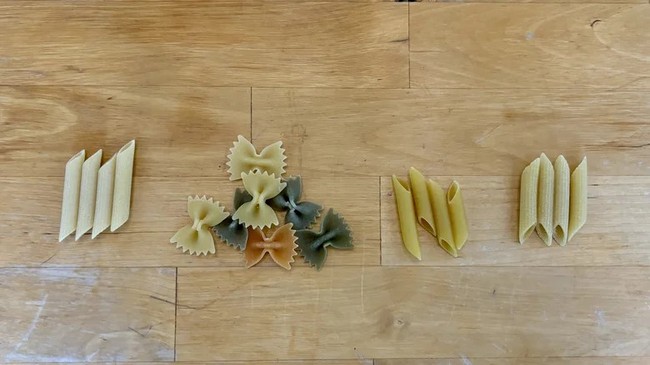
Helena Nichols/Mashed
These pasta brands look quite different, and would not be mistaken for each other. Even the packaging varies considerably. Garofalo pasta comes in a clear plastic bag that showcases the pasta. The logo and writing are on it, but clearly, Garofalo management is trying not to obscure the view of the actual pasta. This adds a certain elegance and simplicity to the overall product.
Barilla, on the other hand, comes in cardboard boxes that feature a clear plastic window. You can still see the pasta inside, but that is not the whole focus. Additionally the bright blue color of the original box is striking and eye-catching. This shade of blue has become a standout feature of the brand. The brand literally calls its original varieties the Classic Blue Box line of pasta. The Al Bronzo is similarly packaged, but in a red box, most likely to set it apart visually.
As for the pasta itself, the first thing I noticed is that even though I tried penne-style pasta across both brands, the pasta looked different. The classic Garofalo penne seemed more pale than the Barilla version. Additionally, I also found more variations in sizes and shapes among the Barilla options than I did for the Garofalo pastas.
Do the Garofalo and Barilla pastas taste different?
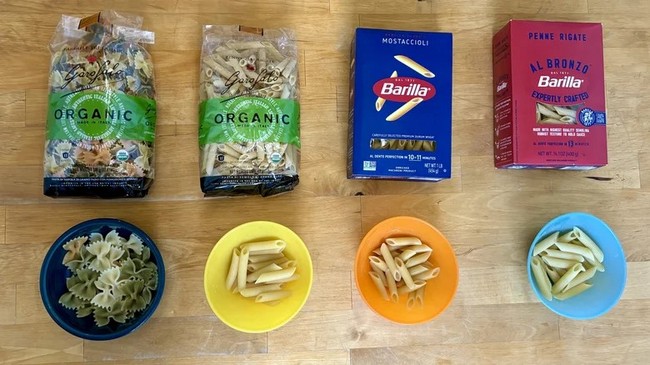
Helena Nichols/Mashed
I'm going to be very frank with you right now, and tell you that for the most part, these pastas all tasted nearly indistinguishable from each other. The one exception was Garofalo's tricolor farfalle. The only reason this was an exception is because the tomato and spinach flavorings had a notable impact. Both of those pasta pieces taste earthy from the vegetable content that is in them. It would likely be less noticeable with a sauce, but I tried them plain.
Now, on to the Barilla Blue Box pasta, the Al Bronzo, and the Garofalo. I spent a lot of time agonizing over these samples, and have come to the conclusion that any taste difference is negligible. The Garofalo and the Al Bronzo were both slightly thicker than the classic Barilla pasta. The Al Bronzo also required an additional two minutes to cook. The Garofalo and the Al Bronzo varieties also offered a bit more chew than the Barilla Blue Box pasta. But, this was a very slight difference. As for Garofalo's tricolor pasta, its texture was not as pleasantly chewy, and it required 15 minutes of cooking time, which likely did not help its consistency.
The flavors overall were shockingly similar. I knew which pasta I was eating, but had this been a blind taste test, I doubt I could have told you which brand was which. The ingredients are so simple; there is only so much flavor variation to be had between the two brands.
A clear winner
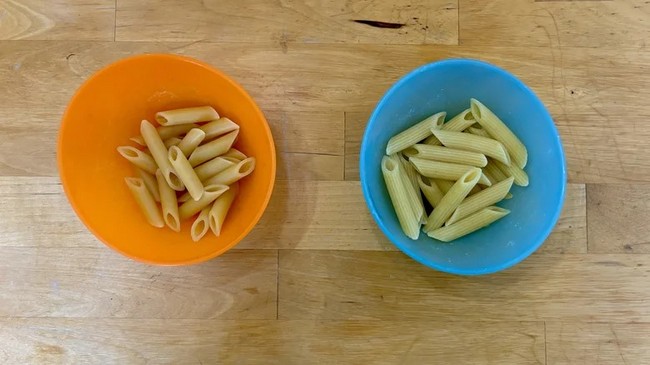
Helena Nichols/Mashed
This investigation may change my pasta-purchasing habits. I have always made a point of buying Garofalo in bulk at Costco, but this may change. Don't get me wrong, it is delicious and well-made pasta. However, when compared side-by-side, I did not find it substantially better than even Barilla's classic Blue Box pasta. The texture and flavor is nearly identical. The most important factor for both brands is to cook the pasta correctly, and not let it turn mushy. If you cook the pasta properly, you won't go wrong.
Overall, Barilla is easier to find, and comes in more shapes and varieties, which makes it preferable when considering flexibility to pair different pastas with varying sauces. I am generally a bulk buyer who really cares about the quality of the food I bring into the house. Garofalo has a wonderful reputation and exudes quality. But when I got right down to the nitty-gritty of it, I really just did not notice that much difference between the two brands. And the fact that Barilla has more nutrients is great for those of us trying to get extra vitamins and minerals into our kids. Because of these reasons, I may start buying Barilla instead of Garofalo.
Methodology
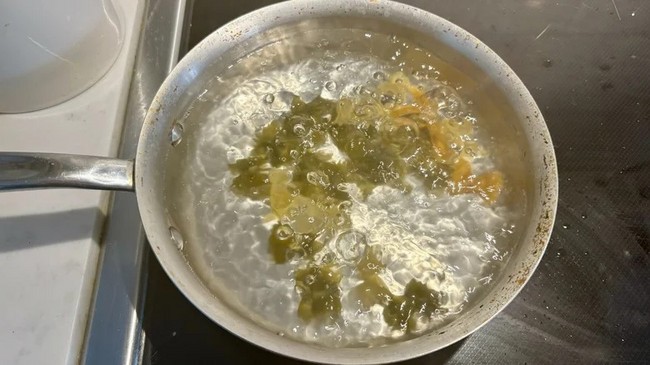
Helena Nichols/Mashed
To decide whether Garofalo or Barilla makes the best pasta, I naturally had to try them both. For this, I wanted to test a couple varieties from each brand before deciding. To do this I taste-tested Barilla's regular pasta as well as the Al Bronzo brand. For Garofalo, I tasted the penne — which is part of the organic line of pasta they offer — as well as a tricolor farfalle. In the interest of direct comparison, I tried a penne from both brands, and cooked each of them according to the brand's instructions to ensure a fair comparison.
In addition to comparing the pasta itself, I considered the price and availability differences. While taste was the predominant deciding factor, it was important for me to note whether one pasta's flavor was substantially better enough to outweigh the differences in cost and availability.
Previous:Amcor markets recycle-ready solution for baked goods to maintain freshness and reduce packaging fees
Next:The Absolute Best And Worst Canned Fish To Buy At Aldi
Hot key words
Hot Products
Popular Vendors